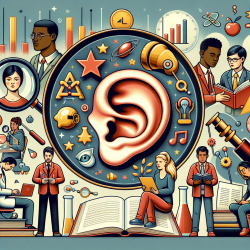Introduction
In the ever-evolving field of audiology, practitioners are constantly seeking innovative ways to enhance their skills and improve patient outcomes. The recent research article, "Conditional Ablation of Glucocorticoid and Mineralocorticoid Receptors from Cochlear Supporting Cells Reveals Their Differential Roles for Hearing Sensitivity and Dynamics of Recovery from Noise-Induced Hearing Loss," offers valuable insights that can be leveraged to refine therapeutic approaches and encourage further research.
Understanding the Research
This groundbreaking study investigates the distinct roles of glucocorticoid (GR) and mineralocorticoid receptors (MR) in cochlear supporting cells, particularly in relation to hearing sensitivity and recovery from noise-induced hearing loss (NIHL). The research utilizes conditional gene manipulation techniques to explore how these receptors influence cochlear health in mice.
The findings highlight that GR ablation leads to hypersensitive thresholds and a permanent threshold shift in response to mild noise exposure. In contrast, MR ablation shows a recovery trend, with thresholds becoming more sensitive over time. These results underscore the complex interplay between these receptors and their potential impact on hearing restoration strategies.
Implications for Practitioners
For practitioners, these insights can be transformative. Here are some ways to integrate these findings into practice:
- Tailored Therapeutic Approaches: Understanding the differential roles of GR and MR can guide personalized treatment plans. For patients with noise-induced hearing loss, therapies targeting these receptors might be developed to enhance recovery and prevent permanent damage.
- Focus on Prevention: The research suggests that managing stress and hormonal balance could play a role in protecting against hearing loss. Encouraging patients to adopt stress-reduction techniques and maintain hormonal health could be beneficial.
- Encouraging Further Research: The study opens avenues for further investigation into the molecular mechanisms of hearing loss and recovery. Practitioners can contribute to this growing body of research by collaborating with researchers or conducting their own studies.
Encouraging Further Exploration
While this research provides a foundation, it also highlights the need for continued exploration. Practitioners are encouraged to delve deeper into the molecular dynamics of cochlear health. By staying informed and engaged with the latest research, they can remain at the forefront of audiological care.
Conclusion
The insights from this study offer a promising pathway for enhancing therapeutic strategies in audiology. By understanding the roles of GR and MR in cochlear health, practitioners can better address the challenges of noise-induced hearing loss and improve patient outcomes. As the field continues to evolve, staying informed and proactive in research and application will be key to success.
To read the original research paper, please follow this link: Conditional Ablation of Glucocorticoid and Mineralocorticoid Receptors from Cochlear Supporting Cells Reveals Their Differential Roles for Hearing Sensitivity and Dynamics of Recovery from Noise-Induced Hearing Loss.










